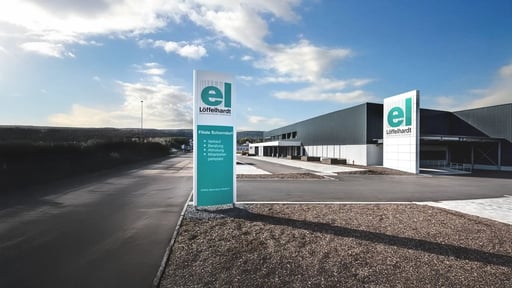
Grow Revenue With a Future-Ready B2B Ecommerce Platform
Deliver tailored experiences and meet your customers where they are with a modular B2B digital commerce platform built to scale and flex with your business.
Grow Revenue With a Future-Ready B2B Ecommerce Platform
Deliver tailored experiences and meet your customers where they are with a modular B2B digital commerce platform built to scale and flex with your business.
Why Leading B2B Enterprises Choose Spryker
Spryker gives you the speed and flexibility to launch, adapt, and scale without compromise. Serve complex B2B buying journeys with tailored workflows and accelerate time to market using powerful out-of-the-box capabilities.
Personalize every step of the B2B buying journey
Streamline your operations
Launch what’s next, without the wait
Reduce cost of sales
Gartner Ranks Spryker #1 for Complex Commerce
Spryker was ranked #1 in the Complex Business Models use case in the 2025 Gartner® Critical Capabilities for Digital Commerce report. This category evaluates how well vendors support advanced use cases, including:
- Complex, assembled, or customized products
- Mixed portfolios of physical goods, digital products, and services
- Emerging models like subscriptions and marketplaces

Accelerate Time-to-Market With Leading B2B Capabilities
Optimized Purchasing Journey
Personalized Account Management
Collaborative Buying
Agent Assisted Buying
Configure Price Quote (CPQ)
Dynamic Order Management System
B2B Enterprise Marketplace
Gain Speed and Agility Without the IT Complexity
Fully Composable
API-First and Headless
Industry-Leading Extensibility
Cloud-Native PaaS
Security and Governance Ready

Customer Success Stories
Discover how other B2B enterprises grew their business with Spryker.
“ Spryker’s modular solution provides the flexibility we need today to meet the global challenges of tomorrow. ” Sebastian Schulmeister,Group Lead E-Business Services
Sebastian Schulmeister,Group Lead E-Business Services
“ We were particularly impressed by Spryker's B2B feature set and the modular system architecture, which together enable flexible development and a strong focus on B2B customers. ” Gunther Hahn,Head of SLV Digital
Gunther Hahn,Head of SLV Digital
“ We wanted to go beyond the market standard, not just offering a polished e-shop. Our goal was to achieve a one-stop shopping experience for our customers and Spryker delivered on our promise. ” Dr. Mark Wever,Global Chief Digital Officer
Dr. Mark Wever,Global Chief Digital Officer
Frequently Asked Questions
Find answers to commonly asked questions about Spryker’s B2B platform.
Spryker is a flexible, scalable B2B commerce platform with extensible workflows that can be tailored to your unique business needs — no matter how complex. Our industry-leading composability and modular approach ensures you can integrate seamlessly with any third-party services, maintaining your competitive advantage without compromising on operational efficiency.
Yes. Spryker supports workflows like approvals, quotes, contract pricing, shared carts, and role-based access, all tailored to your organizational needs.
Yes. Spryker enables multiple business models from a single platform, so you can manage B2C, D2C, and any other operations alongside your B2B marketplace.
Spryker’s out-of-the-box B2B capabilities and modular architecture enable fast deployment. Launch a tailored MVP in weeks and expand functionality as needed without rebuilding.
Spryker is a cloud-native platform as a service (PaaS). Unlike SaaS platforms, which limit customization and control, PaaS gives you the freedom to tailor workflows, extend capabilities, and integrate with your systems without being locked into vendor release cycles.

Expert Insights
Resources for building a revenue-driving, future-ready commerce platform.

Business Intelligence powered by Amazon QuickSight | Spryker
Loading resources...

ESA – More Than an Automotive Supplier

Hardeck – Performance Boost Enables Front-end Development

Jungheinrich’s Unlimited Digital B2B Growth Thanks to Centrally Managed Glocalization

Kömpf - 28 Shops with Outstanding Experience and 150% in Sales Growth

Lekkerland – Tech Focus and Digital Mindset in Convenience Retail

Lumas converts first-time art buyers with a smart commerce platform

ROSE Bikes – Start into the Race with Technology Ownership

SLV Doubles Traffic and Boosts Revenue with B2B an Elevated Digital Commerce Experience

STAUFF Delivers Customer-centricity with a Self-Service Portal

VIABIRDS: Making eGrocery convenient for everyone

Winterhalter + Fenner reinvents customer-centric navigation

Siemens Healthineers - Creating a Patient Experience Beyond Commerce

Emil Löffelhardt's wholesale B2B transformation with Spryker

Meusburger simplifies the procurement of high-precision parts with sophisticated product configurators and assistants

SWISS KRONO embodies customer-centricity with a scalable self-service portal

KoçZer's ZERGO: Turkey’s first B2B marketplace for supply chain management

NEW FLAG: A B2B wholesale solution for the beauty industry

PFERD Boosts Revenue, Efficiency, and Customer Experience with Spryker

B2B Spare Parts Marketplace for Commercial Vehicles

COLONS simplifies B2B procurement in the sanitary industry

Optibelt drives efficiency with a new global B2B commerce platform
Get Your Personalized B2B Demo Today.
Explore our solutions and resources tailored to your business needs.
